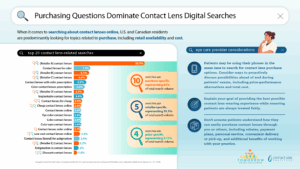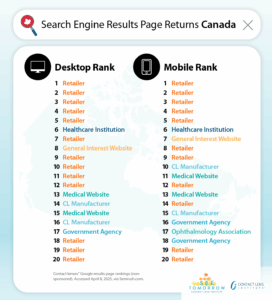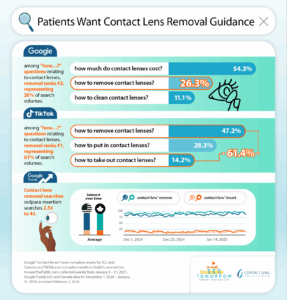Contact Lens Institute (CLI) has published Digital Discovery: Consumer Searches Reveal Contact Lens Realities, a comprehensive look at how and why people are seeking more information about these products online. The latest in CLI’s See Tomorrow initiative series, the 30-page report is available for free download or on-demand reading at https://www.contactlensinstitute.org/resources/digital-search/.

“Patients are posing questions about contact lenses to search engines, artificial intelligence (AI) platforms, and social channels that they may never raise in the exam chair. By understanding what’s being asked, eye care practitioners and staff can reconsider how they’re presenting contact lens wear, care, and purchase options,” said Stan Rogaski, CLI’s executive director. “Based on preliminary findings that we shared earlier this year, some practices are already adjusting how they’re communicating with and educating wearers, plus evolving their practice management techniques. This report goes much further, with perspectives that are broadly applicable.”

The report examines multiple aspects of search behaviors, culled from public data sources, primarily focused on the United States and Canada. These include diving into the most common contact lenses searches via Google auto-complete results, 65% of which are purchase driven. A companion review of rising related topics illustrates that frequent brand and retailer searches indicate extensive comparison shopping—reasons for practices to actively speak with patients about buying decisions.

CLI data also sheds light on the most common questions that reveal patient challenges, suggesting that the contact lens community may benefit from increased focus on health and safety, cost, wear and care, and how brands differ. Some of these same questions posed to internet-connected ‘smart speakers’ uncover a different opportunity: the importance of optimizing a practice’s website for location-based search. This includes liberally incorporating the term “eye doctor” into digital content—the preferred shorthand for patients looking for contact lens clinical sources.
AI Platforms and Evolving Search Technologies
As traditional digital search evolves with the adoption of AI platforms, CLI also investigated how common large language models such as ChatGPT, Copilot, and Gemini are handling contact lens queries. While steadily advancing, those technologies’ abilities to provide the best sources of information are inconsistent, meaning that practitioners may want to have preemptive conversations about AI-generated results with patients who are likely users. Recent studies indicate that 40% of U.S. adults ages 18-64 have used generative AI (National Bureau of Economic Research, 2024) and that 47% of Canadian adults have used AI tools (Leger, 2025).
Additional areas explored in the report encompass searches for different contact lens modalities, insertion and removal guidance, part-time contact lens and glasses wear, regional and global differences on X (Twitter), and use of languages other than English.
CLI Visionaries—leading optometrists and opticians from the U.S. and Canada—contributed 16 ‘how to’ columns, each offering practical advice on using the data and insights in practice. These are supplemented by 15 data-rich infographics and charts.

“Our latest report delivers a snapshot of what may be on the minds of the person considering contact lenses for the first time as well as new and long-time wearers, helping the thousands of professionals in eye care remain one or more steps ahead as the ultimate experts,” said Rogaski. Contact Lens Institute advances the latest innovations in safe and effective contact lens and lens care products and services that provide unique benefits to patients while satisfying the evolving needs of eye care professionals. CLI undertakes activities that properly assess, enhance, promote and balance contact lens and lens care industry welfare and growth, including the safe use of products in the marketplace. Its members include Alcon, Bausch + Lomb, CooperVision, and Johnson & Johnson Vision. For more information, visit contactlensinstitute.org.

